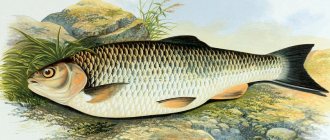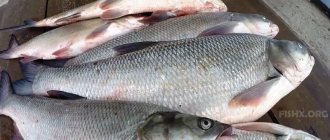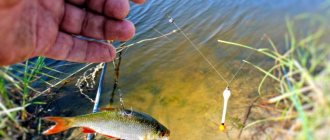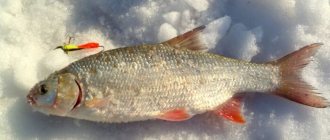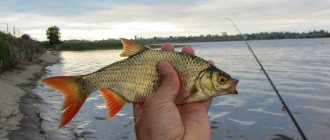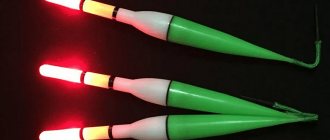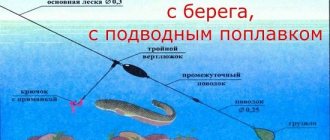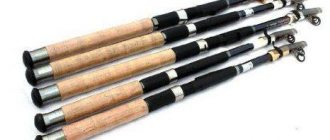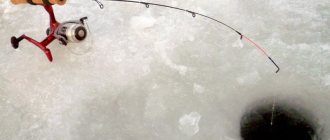Gear used
Peaceful fish are distinguished by their caution and delicate bites. Therefore, all components of the equipment should be as sensitive and inconspicuous as possible. The design includes a fishing rod, reel or reel, float, line and sinkers.
Rod
A winter float fishing rod does not need a long rod, since it is only needed to hook a fish that has bitten and weaken its first impulses when fishing. And for this, a short fishing rod is also suitable, quite elastic and flexible, from 30 to 40 cm long. A modern winter fishing rod has a thin and flexible whip, conical in shape, and a small hollow handle. Its design can be solid or collapsible.
Vinyl plastic, bamboo or juniper are used to make the whip, and wood, cork, plastic or foam is used to make the handle. Fishing rods are foldable, which is very convenient for carrying. They are made from aluminum tubes and plastic, equipped with a cork handle.
The fishing rod should be different:
- strength;
- ease;
- elasticity;
- flexibility when hooking fish, but not excessive.
The simplest of the fishing rods for winter fishing with a float rig is the “filly”. It is very reliable, and if the whip is made of durable and frost-resistant material, then it can serve you for many years. The peculiarity of the “filly” is that the fishing line is wound on a reel. Those who find this inconvenient use fishing rods with a reel, for example, a balalaika.
fishing line
For a winter float fishing rod, you should use only new high-quality fishing line, which holds the load better and will last longer. When making lightweight equipment, it is advisable to use soft monofilament, which straightens well under light load. For passive tackle, which is a float rod, this is very important.
There are, perhaps, two specific requirements for fishing line for ice fishing.
Firstly, it is more convenient to work with colored monofilament, which is clearly visible in the snow. What color it will be - yellow, black, red or brown - is not so important. It should be noted that some anglers prefer blue or greenish fishing lines, believing that in reservoirs it is less noticeable to fish.
Secondly, it is desirable that the fishing line be with a special protective coating, which increases its wear resistance and durability. Friction against the edges of the hole and micro-ice on the surface of the water cannot be avoided. In addition, at the end of fishing, we wind wet and cold fishing line on the reel, sometimes with particles of ice on it. When drying at home, the monofilament shrinks, and the turns at the edges of the reel can be pressed into each other. Lines with a protective coating are less damaged.
Coil
There are two types of reels for winter float fishing: closed (they fit into the body of the fishing rod) and open. Any capacious coils can be used as open ones.
Float
For winter fishing you need a lightweight, easily visible in the water and highly sensitive float. Winter floats usually have a well-streamlined cone-shaped or cylindrical shape. To make them, cork, plastic, tree bark, and pieces of goose feather are used. The colors for painting them are chosen to be bright, contrasting, and applied in transverse rings along the entire length. When fishing, the float should be upside down with its flat base.
The size of this tackle is chosen depending on the fishing conditions: for calm waters a small float is used, for rapids a larger one is used.
Sinker
The loading of a winter float fishing rod should ensure that the float is positioned several centimeters below the water level in the hole, then it will not freeze into the ice crust and will not lose its sensitivity. For sinkers, use pellets, pieces of lead or tin, installed 10 - 20 cm above the hook. The load usually consists of the main load and additional load. However, the number of sinkers may increase depending on the experience and personal preferences of the fisherman. The total weight of the load depends on the presence of a current - the stronger it is, the heavier the load should be.
Also, depending on the preferred type of equipment, you can load the float rod with a jig. It is better to use the smallest jig with a diameter of up to 1.5 millimeters. Such jigs are called “droplet”, “pellet” and “ovinka”. Dark-colored tackle with a long hook shank works well.
Hook
The hook must be very sharp. Its size and shape are selected according to the intended bait: it is more convenient to place the bloodworm on hook No. 2-3; when fishing with pieces of meat, worms or bread crumbs, larger hooks are needed (No. 5-7); for fry, hooks No. 8.5-10 with a long shank are used.
Hooks for winter float fishing rod
In winter, the main bait is bloodworms. Less commonly used are maggots and plant attachments. Based on this, the hook is selected. It should be made of thin wire, but not bend and be very sharp. Bloodworms have delicate skin, which is very easy to tear with an insufficiently sharp hook. After this, it immediately loses its attractiveness, as liquid leaks out of it. The bloodworm becomes flabby and inelastic.
If we catch small bream and roach, we use hook No. 18-20. If we are targeting larger fish, we use hooks No. 14-16. We tie all the hooks to leashes at home and wind them on the reel. They are so small and difficult to tie while fishing in summer, and even more so in winter.
Many fishermen use winter jigs. Moreover, they are used in conjunction with hooks. The jig is located at the end of the leash, and the hook is tied at a distance of approximately 25-30 cm above. This equipment option provides clear advantages. Firstly, the fisherman fishes several horizons at the same time, and secondly, the fish are given different baits. This tackle significantly increases the chances of catching perch, roach, bream, etc.
During the fishing process, be sure to check the sharpness of the hooks. If we see that they have become dull, then we either replace them with a new one or, which is better and faster and more economical, sharpen them using a special sharpener for hooks.
Equipment
A winter fishing rod with a float can be equipped in several ways, depending on the fishing conditions: the current and the type of fish being hunted.
Option 1. Using a regular lead sinker and hook. Figure 1 shows fishing without current. Figure 2 - when fishing in the current, the sinker must be lowered to the bottom. The distance in both cases from the hook to the sinker closest to the hook is 4-7 cm.
Option 2. Using a jig and a hook. Figure 3 shows the gear in still water. The line is passed through the jig, the latter is attached, then the hook is attached to the leash. Figure 4 shows equipment for a pond with a current. In this case, you should attach the leash with the hook by passing the fishing line through the top ring of the jig, and not through the entire cavity. This way the jig will easily reach the bottom, and the leash and hook will not get tangled.
Option 3. With a hard leash. Figure 5 shows the use of a small leader made of stiff line and a light hook. Thanks to this tackle, the hook will go a little to the side and will be more noticeable. The same option in the current is shown in Figure 6. Another leash with a non-sinking plastic jig has also been added.
Groundbaits
You should feed the fishing spot. It is best to use long-lasting bait, since the smell of bait can significantly increase the concentration of fish in the fishing area. You can buy ready-made bait, or you can prepare it yourself. The feed mixture must be fresh. The following components of complementary feeding are common:
- cereal grains;
- wheat crackers;
- seeds;
- boiled potatoes;
- worms, maggots;
- special mixtures.
After the components have been selected, it is necessary to mix them dry in a container and dilute them with water from the reservoir, and the viscosity of the bait should be controlled.
Photo of a winter float
Note!
Fishing with a spring - rigs, baits, baits, gear and methods of fishing with a spring (80 photos)
How to tie a fishing line to a reel - methods, tips on how to tie correctly and an overview of the most reliable knots (85 photos and videos)
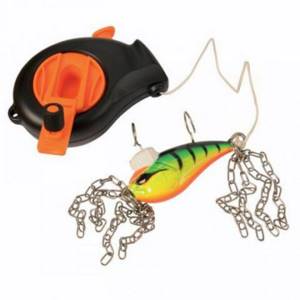
Cuts for wobblers and spinners - how to make a simple homemade cut. 110 photos and videos of practical tips
Help the project, share on social networks 

0
Fishing technique and tactics
Typically, an angler drills several holes and places a fishing rod in each hole. Winter fishing is about constantly searching for fish. The more holes and fishing rods, the greater the chances of finding fish and being with a catch. The holes are made in such a way that the floats of all fishing rods are clearly visible. This is necessary so that you can react to a bite in time.
There are some nuances to using such a fishing rod:
- It is only effective when fishing from ice. Fishing in open water requires the use of different gear.
- It is designed to catch a specific type of "white fish", although it can be adapted for other fishing conditions.
- With its help, it is difficult to find a fish site, therefore, it is better to first find the fish, and only then catch it with this tackle.
The use of a float rod can simplify the fishing process, since you do not need to constantly hold the rod in your hands. The gear is installed near the hole, and you can calmly watch the biting process.
Necessary equipment for float fishing in winter
For fishing with a winter float rod, in addition to the gear itself, you also need a number of gear and fishing equipment:
- Winter feeder is a device with the help of which bait is delivered and unloaded in a heap in the desired horizon;
- Depth gauge - used to measure depths and search for the most promising places for fishing;
- An echo sounder , like a depth gauge, determines depths and schematically indicates the presence of fish;
- Scoop (skimmer) – designed for cleaning drilled holes from ice crumbs;
- Bagorik - helps to pull out large fish;
- Containers for mixing bait - in them, on the reservoir itself, a mixture is prepared from purchased or independently prepared bait and loaded into the feeder;
